No, I didn’t procrastinate this time. I decided to make it a rule to post a wagashi entry on the last day of every month. That way, this blog’s monthly archives will always have a wagashi entry on top, which I hope will give you a taste of the month before you scroll down. :)  Aokaede (Green Maple) Green maple seems to be a popular wagashi theme for early summer and mid-summer in the world of tea ceremony. In this time of the year, being in the shade created by elegant green maple leaves, you can temporarily forget the unbearable heat in the daytime. The soothing beauty must have triggered thousands of confectioners to recreate it with wagashi. This aokaede is basically a kanten jelly with green colored an (sweet bean paste) just partially covering the top. It is amazing that having this small green part on top can give you a stronger impression of greenness than coloring the entire jelly green. ------- Another kanten jelly with the theme related to something cold...  Kanzesui This whirlpool shape is called Kanze-sui or Kanze-mizu 観世水, which is one of Japanese traditional patterns. It derived from the crest of Kanze family -- the famous noh (Japanese traditional drama) master’s family. The design symbolizes the water ripples in the well at their family shrine in Kyoto. The dark spots on the right are a couple of azuki beans representing pebbles in the clear water. Kanzesui jellies often contain small beans, and they give a nice accent to the taste and texture of the jelly. Wagashi by Shingetsu * These photos were taken with my old camera. Categories: Wagashi |
Monday, July 31, 2006
Sweet Seasons/July 2006 - Green Maple -
Posted by
obachan
at
7/31/2006 11:16:00 PM
13
comments
![]()
Saturday, July 29, 2006
Road to an Edamame Expert
 Boiled Edamame (Green Soybeans) The key is “4%.” Remember this percentage when you boil fresh edamame. According to them, 4% salt water is considered to best bring out the soft but crispy texture and sweetness of the green soybeans. So the recipe they suggested was: 250 g fresh edamame (green soybeans) 1000 mL water 40 g salt So this must be the golden ratio of edamame boiling. Now, to make your edamame tastier, you need some special preparations before boiling them.  First, wash the beans and cut off ends. This is to let the beans absorb salt better. (According to them, edamame cannot absorb salt as effectively as other beans.) First, wash the beans and cut off ends. This is to let the beans absorb salt better. (According to them, edamame cannot absorb salt as effectively as other beans.)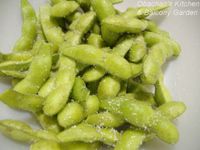 Place edamame in a bowl. Take some salt from the 40 g salt mentioned in the recipe, sprinkle all over the beans and rub them well. Do NOT wash off the salt. Place edamame in a bowl. Take some salt from the 40 g salt mentioned in the recipe, sprinkle all over the beans and rub them well. Do NOT wash off the salt.Heat 1000 mL water in a pot and bring to a boil. Add the remaining salt, edamame and the salt left in the bowl after rubbing the beans, too. The boiling water should be 4% salt solution.  Boil for 3 to 5 minutes. Do not boil more than 5 minutes because the beans will lose amino-acids which are supposed to make them taste good. Some websites say that the beans turn out greener if boiled with the lid on. Others say do not close the lid because some volatile acid from the beans will stay in the pot and ruin the taste. (I put the lid on but did not close it completely.) Boil for 3 to 5 minutes. Do not boil more than 5 minutes because the beans will lose amino-acids which are supposed to make them taste good. Some websites say that the beans turn out greener if boiled with the lid on. Others say do not close the lid because some volatile acid from the beans will stay in the pot and ruin the taste. (I put the lid on but did not close it completely.)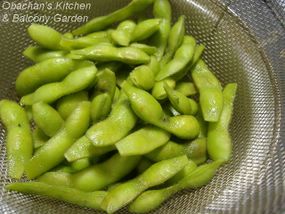 Drain and cool by fanning. It is not recommended to dip them in cold water to cool, because it would wash off some salt and make the beans rather soggy. Drain and cool by fanning. It is not recommended to dip them in cold water to cool, because it would wash off some salt and make the beans rather soggy.The result: Yeah, I liked the texture very much, but to be perfectly honest, it was a bit too salty for me. So I suppose I need to give a little twist to their golden ratio and use less salt to suit my palate.  It’s kind of strange… looks like I’m acquiring taste for spicy food as I get older, but as for saltiness, what used to be OK tastes too salty for me now. These days I can’t eat hiyayakko (chilled tofu with condiments) with straight dark soy sauce. I use wari-joyu which is the mixture of soy sauce and dashi stock. Does this mean that I’m getting old? BTW, have you noticed that now I have a camera with a super-macro function?? Yes, I bought a used camera two days ago. It’s for shooting photos at the big dance festival coming soon. In addition, I'm going to need some good photos of printable quality in the near future, so I immediately went for it when I found a real good buy online. (Acrually, this camera might change my life...) Categories: Japanese |
Posted by
obachan
at
7/29/2006 09:24:00 PM
23
comments
![]()
Wednesday, July 26, 2006
Apricot Day
 Apricot Jam 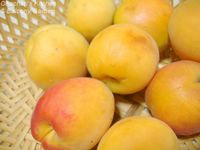 When I found some apricots in the “discount” section of a supermarket yesterday, I thought I was really lucky, because we don’t see fresh apricots around here very often. The ones I found did not look ripe but already turning brown here and there, so they were obviously meant to be cooked/baked with lots of sugar. When I found some apricots in the “discount” section of a supermarket yesterday, I thought I was really lucky, because we don’t see fresh apricots around here very often. The ones I found did not look ripe but already turning brown here and there, so they were obviously meant to be cooked/baked with lots of sugar.I decided to use half of them for apricot cobbler and the rest for apricot jam. 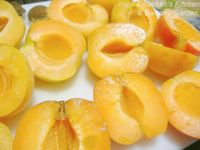   Apricot Cobbler   I think I have seen something like this on the net before… I mean, putting some kind of spread on a rusk (melba toast?) and topping it with a rosemary sprig. It looked so nice that I have been wanting to recreate it someday, and finally the “someday” came. Maybe this combination of cream cheese, apricot jam and rosemary is rather strange, but I was quite satisfied … visually. The taste? It was... OK. :) I think I have seen something like this on the net before… I mean, putting some kind of spread on a rusk (melba toast?) and topping it with a rosemary sprig. It looked so nice that I have been wanting to recreate it someday, and finally the “someday” came. Maybe this combination of cream cheese, apricot jam and rosemary is rather strange, but I was quite satisfied … visually. The taste? It was... OK. :)Don’t you just love the cheerful orange color of apricot jam? Categories: Sweets |
Posted by
obachan
at
7/26/2006 11:26:00 AM
13
comments
![]()
Labels: Pies/Tarts
Sunday, July 23, 2006
Tuna and Avocado Carpaccio
| Tuna and Avocado Carpaccio Yes, tuna was on sale today. The dressing I made for this carpaccio was almost like basic French dressing in the beginning. Then I felt like adding a little Balsamic vinegar, just from curiosity, and finally a few drops of soy sauce, too. I thought the dressing went well with the onion slices and avocado rather than the fish. :P Categories: Western-inspired |
Posted by
obachan
at
7/23/2006 08:04:00 PM
5
comments
![]()
Labels: Fish
Saturday, July 22, 2006
Lime Chiffon Cake
 Lime Chiffon Cake Today I tried out a chiffon cake recipe that I copied from a recipe book at my parents’ house. No, it was not my mom’s book; it was my younger sister’s. She left several recipe books there so that she can cook/bake when she stays there with her kids for a few weeks in summer and winter. My oven can take the smallest (10 cm, I guess) chiffon pan only, so I needed to scale the recipe in half. (Actually bigger ones CAN fit in there, but it does not leave enough space to bake a chiffon cake successfully.) The cake rose alright and didn’t fall at all after it was cooled, so I was very happy. But as you can see, I did a terrible job removing the cake from the pan. See the ragged bottom, I mean, the top in this photo? Well, such a problem should have been easily solved with some whipping cream… if I had any. I thought I had some in the fridge, but of course, I was wrong. And it was raining outside. Hence, this photo. ;P But the cake tasted good. For my next attempt, I’ll buy a better knife – or maybe, whipping cream. ;) ----- * To those who are going to leave email addresses in the comment section: You might want to spell out your email address like “xxxxxx at hotmail dot com” (replace xxxxxxx with what you have before the @ mark in your email address) to protect it from email harvesting robots. Categories: Bloopers, Sweets |
Posted by
obachan
at
7/22/2006 10:21:00 PM
26
comments
![]()
Labels: Cakes
Kaiseki Chronicles #4
|
Posted by
obachan
at
7/22/2006 01:02:00 PM
10
comments
![]()
Labels: Kaiseki
Thursday, July 20, 2006
Obon in My Hometown
I went to my hometown over the long weekend (last Saturday, Sunday and a national holiday on Monday) because it was obon period there, a time for family reunion. Unusual? Yes. I guess the majority of Japanese celebrate this event in mid August. My hometown is one of the exceptional places. Also, there is no such customs as obon-dance or lantern floating in my hometown, so unfortunately I don’t have much to share with you about “typical” Japanese obon customs that you might have heard of. 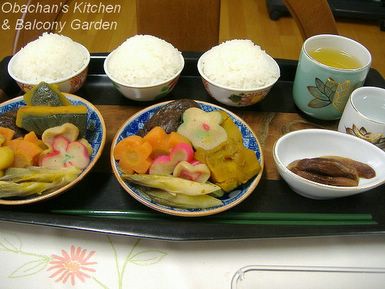 Oryogo. At my parents’ house, this special meal is offered to ancestors during obon and ohigan (equinoctial weeks in spring and autumn). Since Buddha taught people not to kill animals, traditional ceremony food of this religion is almost always strictly vegan. Mom's oryogo this time consisted of cooked rice, tea, water, simmered foods including Japanese pumpkins, black mushrooms, carrots, myoga ginger, flower-shaped “fu (wheat gluten),” and pickles. In the morning, mom or I bring this meal to the family altar, light incense sticks, ring the bell twice and pray VERY briefly. This meal is supposed to be offered to the ancestors before we eat breakfast, but often things don't go straight and family members have to wait with their breakfast on the table while I struggle to pat the cooked rice into a dorm-shape in those tiny bowls. And as soon as the bell is heard, those at the table start eating breakfast. ;P Later (usually at lunchtime) the meal is taken back from the altar to be shared by the family members. It is said that eating oryogo meal will make you healthy (perhaps because the meal absorbs some magical power from being at the altar for a while???)  This photo shows the regular meal offered to the ancestors at my parents’ house. (See how gorgeous the obon version is compared with this regular meal?) Every time rice is newly cooked, a small amount has to be offered to the ancestors first before we eat it. But our family members are awfully flexible, as you might have already recognized from my previous posts on this blog. Sometimes, when we are extremely busy, we say “Sorry!” to the ancestors in our hearts and eat newly cooked rice without offering any to them. Fortunately, we haven’t heard any complaints so far. ;) This photo shows the regular meal offered to the ancestors at my parents’ house. (See how gorgeous the obon version is compared with this regular meal?) Every time rice is newly cooked, a small amount has to be offered to the ancestors first before we eat it. But our family members are awfully flexible, as you might have already recognized from my previous posts on this blog. Sometimes, when we are extremely busy, we say “Sorry!” to the ancestors in our hearts and eat newly cooked rice without offering any to them. Fortunately, we haven’t heard any complaints so far. ;)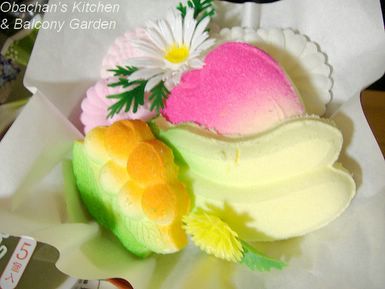 Other than the oryogo meal, we (at least in my hometown) offer sweets and fruits to the ancestors during obon period. This colorful sweet called rakugan is a staple of obon. -------- That weekend, mom and I went for shellfish hunting, because we couldn't do that in May. Nothing stopped us this time. :D The weather was nice -- though a little too hot -- and the waves were not rough at all. And see what I got!   That night, I barbecued the abalones with sake, soy sauce and a dash of yuzu vinegar. Sounds good? Well… they were very fresh indeed, but to be honest, they were not as tender as I wanted them to be. I guess I prefer smaller abalones for barbecuing. Mom also picked bunch of tengusa seaweed on the beach AGAIN. In summer, tengusa is washed up on the beach like this with other seaweed, so all you have to do is to selectively pick what you want from the mixture of slimy plants. Well, when mom does something like that, she is driven and nothing can stop her. I had to beg her so many times to go home.    Tengusa on the beach 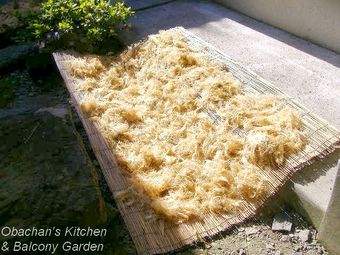 Tengusa being dried at my parents' house  This is an outdoor sink at my parents' house. Most of the houses in the coastal area have a sink like this in the backyard. It's convenient for gutting big fish or soaking swimming goggles in water or leaving the catches from the ocean while washing feet to go inside the house. Remember, we do not wear shoes in the house in Japan. So if we got our feet wet from catching something in the ocean, we have to wash and dry our feet before getting inside the house in order not to make a mess on tatami mats and wooden floor. The floor has to be kept clean for us to walk on without wearing shoes. This is an outdoor sink at my parents' house. Most of the houses in the coastal area have a sink like this in the backyard. It's convenient for gutting big fish or soaking swimming goggles in water or leaving the catches from the ocean while washing feet to go inside the house. Remember, we do not wear shoes in the house in Japan. So if we got our feet wet from catching something in the ocean, we have to wash and dry our feet before getting inside the house in order not to make a mess on tatami mats and wooden floor. The floor has to be kept clean for us to walk on without wearing shoes.Anyway, the fact I'm trying to ignore is that there is going to be a new addition to mom’s stock of dried tengusa, maybe followed by some more additions before the end of this tengusa season... Ahhhh....! |
Posted by
obachan
at
7/20/2006 04:32:00 PM
14
comments
![]()
Labels: Special occasions
Friday, July 14, 2006
Cherries in Sherry - Cherry Clafoutis -
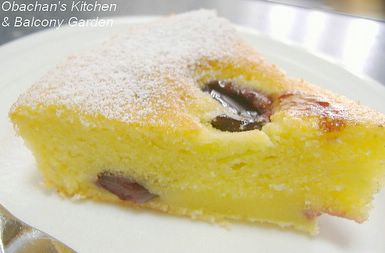 Mimi's Cherry Clafoutis -- Obachan's Version I really want to thank LPC for sharing the recipe for this lovely cake. When I stumbled into the cherry clafoutis post on her site at the end of June, I thought, “OMG, this is something I’ve got to try!” The cherries showing from the batter were just so irresistible. So finally today, I tried out her recipe, and had a GREAT success !! :D  I have to admit that my cake didn’t have as many cherries as hers. Well, American cherries are rather expensive around here. But still the result didn't disappoint me. I have to admit that my cake didn’t have as many cherries as hers. Well, American cherries are rather expensive around here. But still the result didn't disappoint me. I soaked the cherries in sherry for 15 to 20 minutes beforehand as someone mentioned in her comment to LPC’s post. (Yes. What's in the photo is halved cherries in sherry.) It was definitely a good idea, as I had expected. Also I added a twist or two of my own—I replaced about 1/3 of the flour with almond powder, and used soy milk in place of milk. And the result was a scrumptious combination of soft, moist and rich (but not heavy at all) cake and refreshing cherries! I soaked the cherries in sherry for 15 to 20 minutes beforehand as someone mentioned in her comment to LPC’s post. (Yes. What's in the photo is halved cherries in sherry.) It was definitely a good idea, as I had expected. Also I added a twist or two of my own—I replaced about 1/3 of the flour with almond powder, and used soy milk in place of milk. And the result was a scrumptious combination of soft, moist and rich (but not heavy at all) cake and refreshing cherries!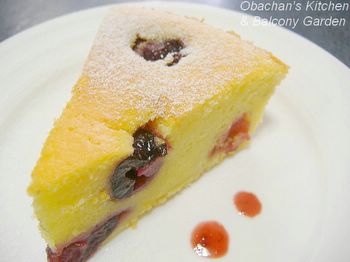 Categories: Sweets |
Posted by
obachan
at
7/14/2006 12:50:00 AM
18
comments
![]()
Labels: Cakes
Thursday, July 13, 2006
My First and Not-very-successful Attempt
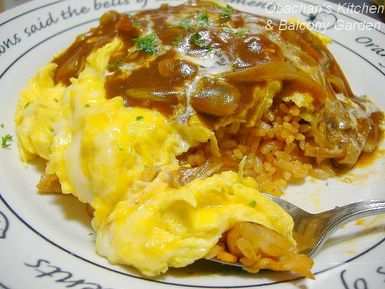 Omuraisu with Demi Glace Sauce While good many people dislike or even hate omuraisu, there seem to be others (not only Japanese) who love this Japanese invention and crave for it every now and then. I have received several comments/emails requesting omuraisu recipe, so now I am working on it... slowly. This is just the beginning phase: trying out recipes that I found on the net so that I can develop my own recipe based on them. I guess my own recipe of “rice rolled in omelet” type of omuraisu is almost ready. But before posting it, I had to try this type: cut-and-opened omelet over rice with demi glace sauce. Yes, I wanted to see which is easier to make and which I would like better. Unfortunately, my attempt today wasn’t very successful, because I overcooked the eggs. I left the omelet in the frying pan a little too long, trying to take a photo there. Also I waited a bit too long after I placed the omelet on top of the rice, taking a shot there again, before cutting it to open. And what made me mad was that those photos were all blurred! But there was something else which was not completely my fault; the strong taste of the demi glace sauce (I used canned HEINZ demi glace sauce) completely killed the flavor of the fried rice. Those who do not care for ketchup-flavored rice may like it that way, but for me, it's no good. To me, what's important for omuraisu is the harmony of the taste of ketchup-seasoned fried rice, sweet but not too sweet omelet, and the ketchup topping. With this type of omuraisu, I can almost always enjoy the harmony. But with the one I made today, I didn’t see any reason why the rice underneath the omelet needed to be seasoned with ketchup at all. That’s probably why many people use buttered rice for this type of omelet. I’ll try this again with buttered rice next time, and if I liked it, I’ll post the recipe. ;) Categories: Japanese |
Posted by
obachan
at
7/13/2006 12:06:00 AM
11
comments
![]()
Labels: Rice dish
Monday, July 10, 2006
Yakiniku with Chima Sanchu
 Yakiniku with "Baby" Chima Sanchu Well, I was going to wait until my chima sanchu leaves grow bigger and turn frillier, because I think that’s the way they should be. Also I was going to give them a little fertilizer or something. But when I checked on them this morning, after the heavy rain last night, a couple of the biggest leaves were almost gone leaving the leaf veins only! I really don’t know if rain brings worms or caterpillars (or slugs?) that eat leaves, but this kind of thing seems to happen almost always after a heavy rain here in my balcony garden. The same thing happened to my mizuna, too. Anyway I decided to go for yakiniku with the still-very-young chima sanchu leaves tonight before the worm(s) consume all of them. So the dinner tonight was this yakiniku, wrapped in small, soft baby chima sanchu. Mmmm… it was OK, but I couldn’t tell the taste of the sanchu leaves at all. ;P Categories: Asian-inspired |
Posted by
obachan
at
7/10/2006 12:12:00 AM
2
comments
![]()
Raspberry Cobbler
 Raspberry Cobbler with Vanilla Ice Cream The yakiniku dinner was followed by raspberry cobbler with ice cream. (What a combination! :P ) I made this cobbler this afternoon, inspired by this post by Kate, and also feeling the pressure of having to use up the frozen raspberries I bought the other day and didn’t like very much. Categories: Sweets |
Posted by
obachan
at
7/10/2006 12:03:00 AM
0
comments
![]()
Saturday, July 08, 2006
Garden Report - July 2006 -
OK. Let’s start with disappointments so that I can move upward and finish this post with a positive ending ;)  Dog rose  Mizuna  Sweet marjoram and chervil Sweet marjoram looks OK, except they have all these brown things, but I guess they are just flowers that turned brown, not a disease, right? Anyway I’m going to harvest and dry them now. I read somewhere that they should be harvested at the peak of their bloom, so I guess I waited too long… 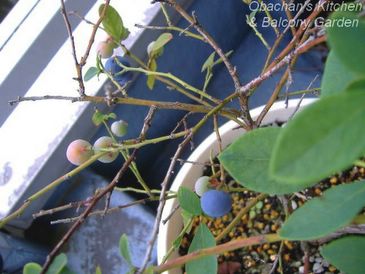 Sunshine Blue I’m definitely going to get more blueberries than last year. (And some are looking pretty big!) But the only problem is that I don’t think I can make “fresh” blueberry pancakes with them this year… As you can see, all blueberries on this plant are not going to be ripe at one time, so to get enough berries to make pancakes, I would have to freeze the ones that ripen earlier and wait for the rest to be ready. Thus it will inevitably be “pancakes with frozen blueberries.” Oh well. It just has to go step-by-step, I guess. Last year, I picked three and a half blueberries. This year it will be more than 20, in total. Maybe in 5 years, I will be able to make fresh blueberry shake with the berries from my balcony garden. ;) 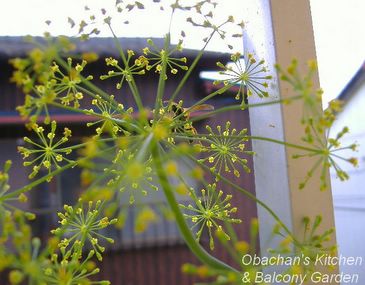 A Bee on dill flowers  Chima sanchu  Yes, my mom’s neighbor did not lie. I see an oblong tomato growing. Stay tuned for the progress of my dry tomato project this summer! Yes, my mom’s neighbor did not lie. I see an oblong tomato growing. Stay tuned for the progress of my dry tomato project this summer!Categories: Garden |
Posted by
obachan
at
7/08/2006 12:52:00 PM
6
comments
![]()
Ginataang Bilo-Bilo?
 Mochiko Balls in Coconut Milk With the leftover coconut milk and mochiko flour from Bibingka, I tried making what ghanima mentioned in her comment -- a dessert she called “pinindot” (and could be the same thing as what avequte called “Ginataang Bilo-Bilo?”). I thought I should have made the coconut milk sweeter, but it was still VERY good! (The topping is dried wolfberries. Strange idea? But I liked it.) Thanks guys for giving me this idea. Categories: Sweets, Asian-inspired |
Posted by
obachan
at
7/08/2006 12:27:00 PM
9
comments
![]()
Wednesday, July 05, 2006
Sake to Sakana #2 Jozen Mizu No Gotoshi
* The author of this post does not recommend sake-drinking to anyone who has not reached the legal drinking age or who should not consume alcohol due to medical/psychological concerns. Sasami no ume-shiso ten (left) and aonori ten (right) Accompanying appetizers tonight were sasami no ume-shiso ten (batter-fried chicken breast fillet with pickled plums and green perilla) and aonori ten (batter-fried green laver). Actually the former was included in our ex-izakaya menu, and the latter is one of the side dishes we offer at our kaiseki place now. 1. Sasami no ume shiso ten   The izakaya version of ume-shiso ten had ume paste and shiso leaves rolled in cut-opened chicken fillets. But my version is a lot simpler; I just minced seeded umeboshi (pickled plums) and shiso, mixed them with chicken chunks, dipped them in batter and deep-fried. I like it that way because it is easier than rolling and it makes the taste of ume a lot milder. I guess you can use white fish in place of chicken breast fillet. 2. Aonori ten 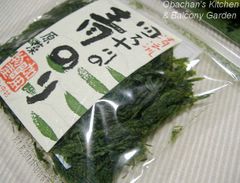 Some people may not like this aonori-ten at all, because it does smell fishy. But let me emphasize this: it is not an unpleasant fishy smell of cheap seaweed. It is much lighter and fresh, which I think deserves a description such as "amazingly flavorful" rather than just "fishy." Some people may not like this aonori-ten at all, because it does smell fishy. But let me emphasize this: it is not an unpleasant fishy smell of cheap seaweed. It is much lighter and fresh, which I think deserves a description such as "amazingly flavorful" rather than just "fishy." 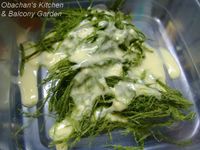 This tempura is also very easy to make. All you have to do is pour a little batter over the green laver and mix, take a little portion of it and flatten with fingers, then drop it in hot oil to deep fry. It is very important to make it as flat as possible so that it turns out pleasantly crunchy. This tempura is also very easy to make. All you have to do is pour a little batter over the green laver and mix, take a little portion of it and flatten with fingers, then drop it in hot oil to deep fry. It is very important to make it as flat as possible so that it turns out pleasantly crunchy.This Jozen mizu no gotoshi went so well with bosh kinds of tempura; It didn’t mess with the strong flavors of ume, shiso and green laver at all. My assumption is that this sake will go well with most foods, creating pleasant harmony, or at least not overpowering anything. And that is where its name came from -- the supreme good described in the verse 8 of Tao Te Ching. I like it. I like it very much. Categories: Sake |
Posted by
obachan
at
7/05/2006 11:53:00 PM
5
comments
![]()
Labels: Deep-fried dish




















 Now as an adult, I enjoy sake once in a while, but until recently I always drank the same local brand, Tosazuru 土佐鶴, non-expensive, regular version (futsu shu) only. And when I go out with my friends, usually sake is not my first choice of drink. After all, beer and cocktails are far more commonly served at parties and karaoke places.
Now as an adult, I enjoy sake once in a while, but until recently I always drank the same local brand, Tosazuru 土佐鶴, non-expensive, regular version (futsu shu) only. And when I go out with my friends, usually sake is not my first choice of drink. After all, beer and cocktails are far more commonly served at parties and karaoke places.